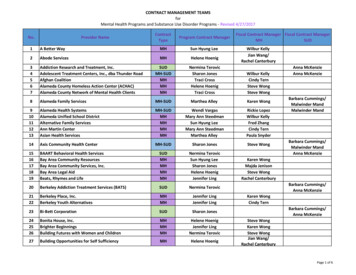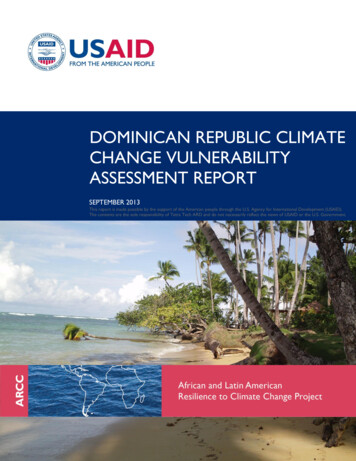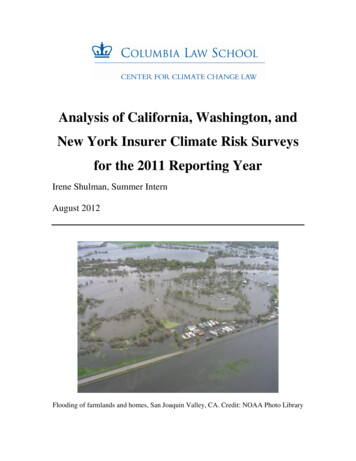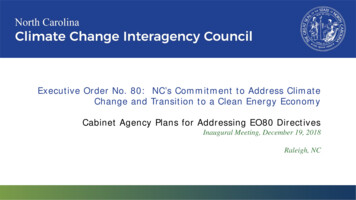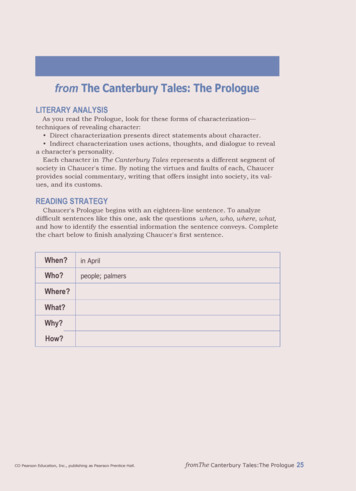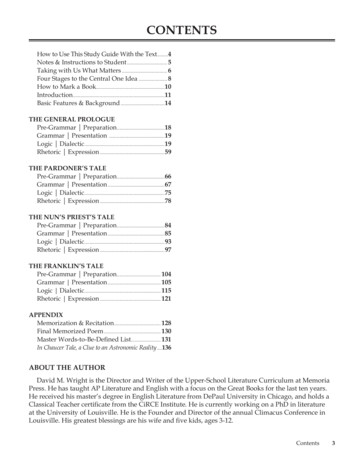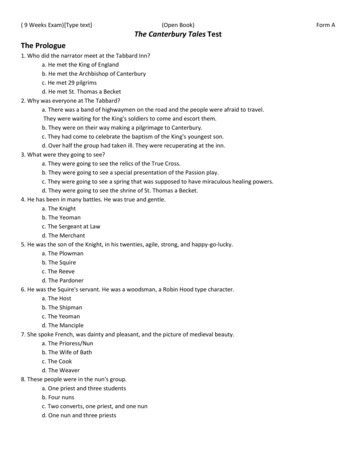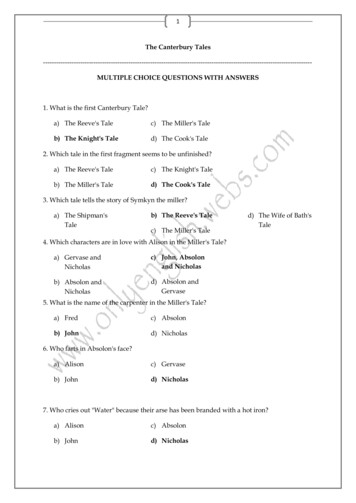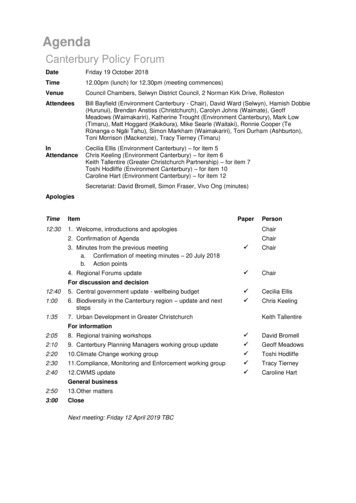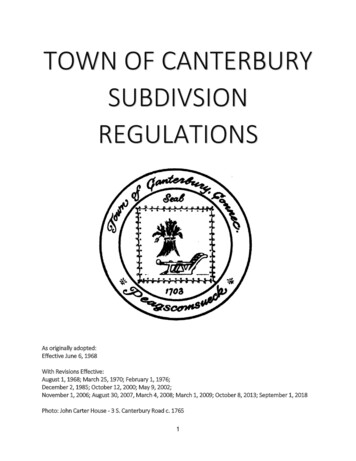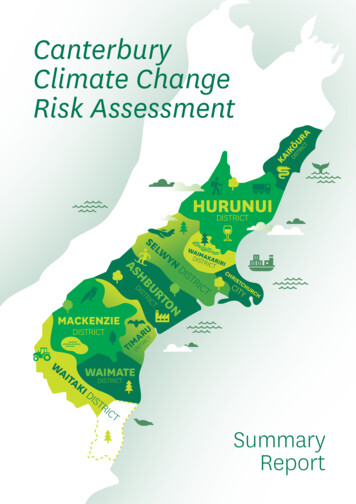
Transcription
KAIDI KŌST URI RCT ACanterburyClimate ChangeRisk AKARRICT IRIDISTRICTNTOURRICTHBDISTASSELWYNCHRISTCITCHURY CHRCUTARITIMDISTWAITA WAIMATEKI DISTRICTDISTRICTSummaryReport
2of 9ForewordClimate change is the biggest environmental challenge of our time. It isalready affecting us, and although we must take mitigation actions now, itwill have broad and ongoing implications for all of Aotearoa New Zealand,across many generations.Regardless of efforts to reduce emissions, science tells us that some aspectsof climate change are already determined for this century, such as the sealevel rising.We need to understand the impact that climate change will have on ourenvironment, and the risks and opportunities associated with it. Doing sonow allows us to best plan for the future.The Canterbury Climate Change Risk Assessment (CCCRA) has beendesigned to build a shared understanding of climate change risks acrossWaitaha/Canterbury, and to help us prepare and respond effectively.The assessment centres around a framework that aligns both a Te Āo Māoriworldview, and the National Climate Change Risk Assessment (NCCRA)framework. The NCCRA, released by the Ministry for the Environment in2020, gave the first national picture of the risks we face fromclimate change.The CCCRA was tasked to the Canterbury Climate Change Working Group,which has been set up by the Canterbury Mayoral Forum. This builds on arisk screening undertaken at the Canterbury Mayoral Forum’s direction in2019, which identified priority risks to form the basis of this work.This project has been supported by a Ngāi Tahu Papatipu Rūnanga SteeringGroup. This Steering Group advised and supported the project team todevelop a Te Āo Māori risk assessment framework to ensure the project wasfit-for-purpose and reflected Waitaha/Canterbury and Ngāi Tahu.Mayor Sam BroughtonChair, Canterbury Mayoral ForumMayor Dan GordonChair, Canterbury Climate ChangeSteering Group
3of 9Te Tīmatanga – IntroductionKei a te pō te tīmatataka mai o tewaiatataka mai o te atuaNā Te Pō, ko Te AoNā Te Ao, ko Te Ao MāramaNā Te Ao Mārama, ko Te Ao TūroaNā Te Ao Tūroa, ko te Kore te whiwhiaNā te Kore te whiwhia, ko te Kore terāweaNā te Kore te rāwea, ko te Kore tetāmauaNā te Kore te tāmaua, ko te KorematuaNā te Korematua, ko te Mākū Ka moe i aMāhoranuiātea, ka puta ko RakiKa moe i a Pokohārua te Pō Ka putako Aoraki, ko Rakamamao tāna koTāwhirimāteaKo te aitaka o te takataKi te whai ao, ki te ao māramaNgāi Tahu values and beliefs define allthings from the time of nothingness – TeKore, through the vast ages of darkness– Te Pō, to the first ever glimmer of light– Te Ao, to the longstanding light – TeAotūroa, through to the emergence ofmoisture – Te Mākū.This shared whakapapa reinforces thetribal philosophy that all things arefrom the same origin. The welfare of anypart of the environment determines thewelfare of the people.It is through whakapapa that all thingsare intricately linked, as well as havingtheir individual place in the world.Ultimately, it is whakapapa that connectspeople to each other, to their ancestors,to the land and natural resources. ForNgāi Tahu, it is whakapapa that elucidatetheir descent from the gods of creation.Ngāi Tahu lay claim to the samewhakapapa as other iwi, through Rakinuiand Papatūānuku and connection to theirdescendants. Whakapapa accounts forthe way in which the earth, sky, oceans,rivers, elements, minerals, plants,animals, and people have been created.Whakapapa explains the very origins ofeverything, past and present, within theMāori world. It is the foundation uponwhich all things are built, the web thatconnects all things together, the anchorwhich holds all things in place and thevehicle by which all things link back tothe beginning of time. Whakapapa bindsNgāi Tahu to the mountains, forestsand waterways and life supported bythem and the Taiao (environment). Allthings are considered to have a mauri(life force), to be living and to have agenealogical relationship with eachother. People are therefore related to thenatural world.Ki te ao tūroa e tū neiTihei Mauriora!Karakia based on ‘Te Waiatatanga mai o te Atua: South IslandTraditions’ original manuscript authored by Matiaha Tiramōrehuin 1849. Translated and edited by Manu Van Ballekom and RayHarlow in 1987, and published by the University of Canterbury.Te Maire Tau, Anake Goodall, David Palmer, and Rakiihia Tau(1990). Te Whakatau kaupapa: Ngāi Tahu resource managementstrategy for the Canterbury Region. (Aoraki Press, Wellington)
4Measuring climatechange projectionsThe world’s climate is changing likewe have never seen before due to theeffects of increasing greenhouse gasemissions. Within this greater context,Canterbury’s climate is also changing.of 9Summary of climate changeprojections for Canterbury by 2100Changes in our climate are projectedto continue into the future, and theirseverity, impact and frequency willdepend on global efforts to curbgreenhouse gas emissions.Drought potentialis likely to increaseacross most ofCanterbury.Currently, climate change modellersuse a set of standard scenarioscalled Representative ConcentrationPathways (RCPs) to measure andexplain the impacts of climate change.These projections show thatCanterbury will see warmertemperatures, including an increasingnumber of hot days and an overallincrease in temperature ranges,as well as decreasing frosts andsnow days.The frequency of extreme weatherevents is also likely to increase,with drought and sea level increasesalso expected.These projected changes are likelyto cause natural hazards such asflooding, wildfires and wind damage.Hot days are those over25 C. It is projected thatthere will be between20 and 60 more hotdays annually by 2100.Wind is likely to increase in speed,and winter and spring are likelyto be windier. This seasonalchange is likely to be morestrongly felt in inlandareas north andwest ofRangiora.The CCCRA was developed using RCP8.5, which indicates the likely outcomeof climate change impacts under ahigh-end scenario where greenhousegas emissions continue to rise over thiscentury. This is sometimes referred toas a business as usual scenario.The National Institute of Water andAtmospheric Research (NIWA) hasdeveloped national and regionalprojections based on RCP 8.5,which have been used as a basisfor the CCCRA.Wildfires will becomemore likely as hotter,drier summers occur.Rural areas will be morehighly exposed.The sea level isprojected to rise byabout 0.8m abovepresent day levels.CANTERAn increase in winterrainfall of 15-40%is expected in theeastern, western, andsouthern parts of theregion. Winter rainfallhas the potential tobe more stronglyassociated withstorm events.Extreme weatherevents (e.g., severestorms) are likely tohappen more often.BURYSummer rainfall isprojected to increaseup to 20% in the inlandCanterbury Plains. It isprojected to graduallyreduce towards coastalareas, with a decreaseof 5-15% in the areaaround Christchurch.As temperaturesrise, there will beless snow daysacross the region.It is projected that therewill be 20-50 fewercold days per year,where the temperatureis at or below 0 C.Our annual meantemperature is setto rise by 1 . 5 -3.5 C.Overall, our maximumdaytime temperatureswill be up 2-5 C.Canterbury's alpine andsubalpine areas couldbe 5-6 warmer.
5An integrated climate change framework:Te Tūtei o Te Hau: Surveillance of the Windof 9An integrated framework was developed for theCCCRA, in collaboration with a Papatipu RūnangaSteering Group, to provide a clear understandingof key climate risks to the Canterbury region andour communities.Te Whāriki o te Ora: The black ring representswhakapapa, or genealogical connection, that extendsfrom the spiritual realm to that of the human domain.It recognises that humans cannot exist without basicneeds and a social foundation.The development of this integrated framework isaligned with the NCCRA framework and centresaround a Te Āo Māori worldview.The framework has been gifted the name ‘Te Tūteio Te Hau: The Surveillance of the Wind’.Te Ao Mārama: The green ring represents the areain which humans can exist when we are functioningwithin the capacity of our ecosystems. Ngā pono(the values) identified within this circle are criticalfor us to understand and respond to when consideringclimate risk.When considering the effects of climate change,observations in the CCCRA have been consideredagainst this framework, our alert system, forunderstanding climate risk.Hā Tuamātangi: The red ring represents the upperlimit in which humans, environments and ecosystemscan continue to exist. Beyond this boundary, it is nolonger possible to respond to risks proactively.Shown outside the rings are the key climateimpacts that we face.Te Ao MaramaChanges in rainfallpatternsThe safe place for humanityand the natural world of lifeand lightRerenga RauropiRangatiratangaBiodiversitySelf governanceFloodingKawanatanga /GovernanceMātaurangaKnowledgeKainga TuturuHistoricheritageTFewer frosts andless snoweWharikioOra riteEquityHāTuamātangi Ou reinfbnogSea level riseHaporiSense ofcommunityWaiWaterTe Tūtei oTe Hau:Surveillance ofthe Windte Ora: FoundatioHauoraPhysical healthNgā aProsperityChLast Breath ClimateExtreme acidificationDroughtThe integrated CCCRA framework developed in collaborationwith a Papatipu Rūnanga Project Steering Group.
Impacts of climate changeacross CanterburyThe challenges of climate change will occur indifferent ways across the region. The large landarea and geographic diversity of Canterburymeans that some risks will be more relevant tocertain areas.Map shows boundaries of the Canterbury region. Waitaki District Council sitsacross the boundary into Otago and therefore is not shown in full in this map.6of 9
MātaurangaKnowledgeNgā WaihangaInfrastructureservicesTe Pō,Ira whenua,Overall riskHaporifindings Ira tāngata2100Present21007of 9PresentHirihiriEnergySense ofcommunity20502050The overall findings in the CCCRAHighly rated risks include those to biodiversity, waterOra riteshow that climate gāponoand infrastructure services.Present-day risks that areEquityPresentHauora2100Prosperity(values) in the framework, and that directandratedextremeincludethoserelated to water supplyPhysical2100healthindirect risks willincrease over time.and irrigation.2050While many present risksare currently rated asPresentinsignificant or low, by the year 2100 there are high orextreme risks against all values. 2100 2050 PresentRisks have been rated based on the likelihood ofbeing exposed to hazards under RCP 8.5 (“business asusual”), and our current capacity to adapt or respondto them.The CCCRA technical report provides an in-depthassessment of the climatechange impacts acrossPresenteach of the eleven values, as well as the potentialimpacts to individuals,communities and 2050High2100HighPresent20502100RangatiratangaSelf Sense ofcommunityTe Pō,Ira whenua,Ira tāngataNgā nergy20502050Ora onomicProsperity21002050PresentPresent2100 2050 Present20502100Summary of risk profiles for each ngā pono (values) from thepresent, through to 2050 and 2100.InsignificanLowModerateHigh
What are our opportunities?In addition to the challenges and risks that climate changepresents, it may provide us with some opportunities. It’simportant to note that opportunities cannot be considered inisolation, but must be considered as part of the broader CCCRA,as the risks often outweigh the benefits.The projected increase in temperature, and reduction in cold daysin winter, could provide the following opportunities:Warmer living conditions in the winter that reduce energyconsumption and improve wellbeing.A longer growing season could present opportunities for thehorticultural industry to increase productivity, reduce crop waste,and grow different varieties within new locations.Increased water storage from winter rainfall.Less disruption to our transport networks due to less snowfalland icy conditions.An increase in both air and ocean temperatures may providea new environment for new marine fish species, potentiallyproviding an opportunity to the fisheries industry.Where to from here?The work to understand the climate change risks we face doesn’tend here.The information we now have from the CCCRA gives us anin-depth, technical overview of the risks and opportunitiesassociated with climate change in Canterbury.The Canterbury Mayoral Forum will continue to work withPapatipu Rūnanga and key stakeholders to consider the riskshighlighted in this report, and work to prioritise these risksat a local and regional level to help inform future planning bycouncils.Understanding the risks and opportunities from climate changenow and into the future is a vital step in our efforts to curb itslong-term impact in our region.8of 9
Notes section
Produced for the Canterbury Mayoral Forumcanterburymayors.org.nzReport Number R21/49December 2021E21/8874
Summary Report. Foreword Climate change is the biggest environmental challenge of our time. It is . through the vast ages of darkness - Te Pō, to the first ever glimmer of light - Te Ao, to the longstanding light - Te . Present Present 2050 2050 2100 2100 Te Pō, Ira whenua, Ira tāngata Ngā Waihanga Infrastructure services Wai Water
